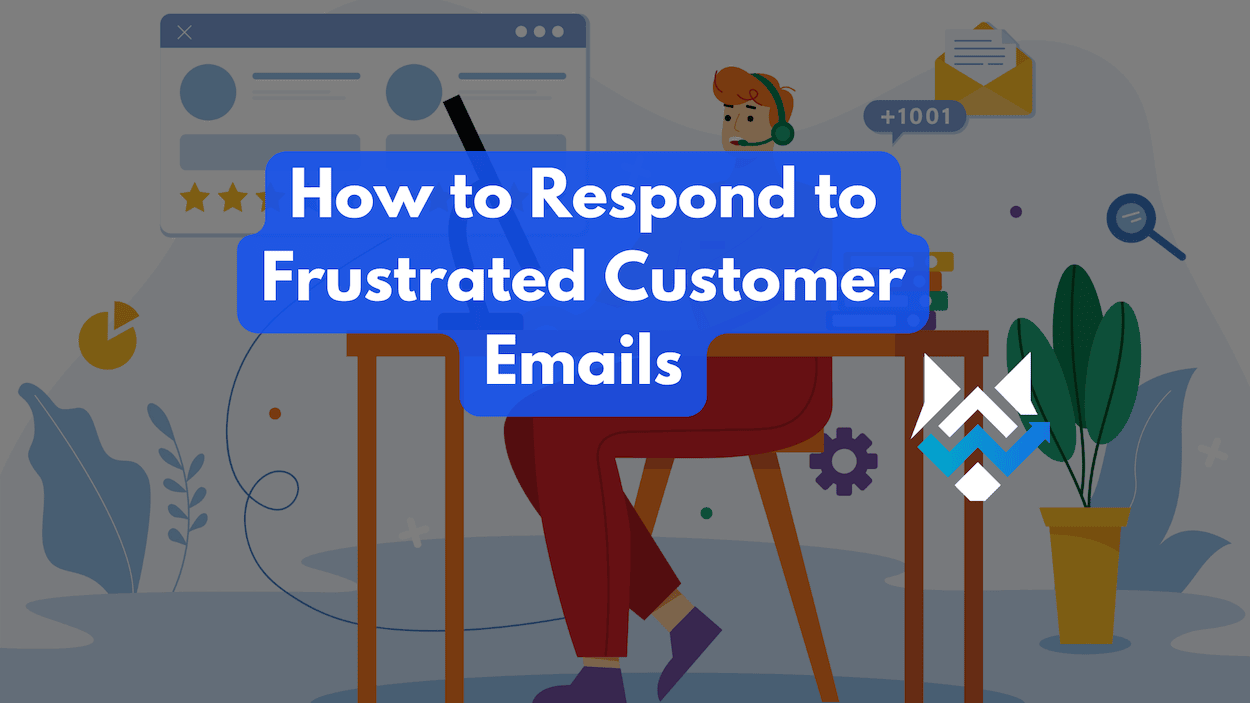No matter how exceptional your product or service is, encountering a few angry customers is inevitable. Knowing how to respond to frustrated customer emails can greatly influence their perception of your business and help turn a negative experience into a positive one.
Handling these situations via email can be challenging due to the lack of non-verbal cues. However, a well-crafted email can turn a negative experience into a positive one, showing that you are genuinely listening and committed to resolving their issue. Let’s start today and turn negative experiences into positive ones!
Why Addressing Angry Customers Effectively Matters
Effectively addressing angry customers is crucial for maintaining your business’s reputation and customer loyalty. Poor handling of such situations can lead to negative reviews, lost customers, and even damage your brand. On the other hand, a thoughtful response can enhance customer satisfaction and turn them into loyal advocates for your brand. Despite its limitations, understanding how to respond to a frustrated customer’s email can make email a powerful tool for resolving conflicts if used correctly.
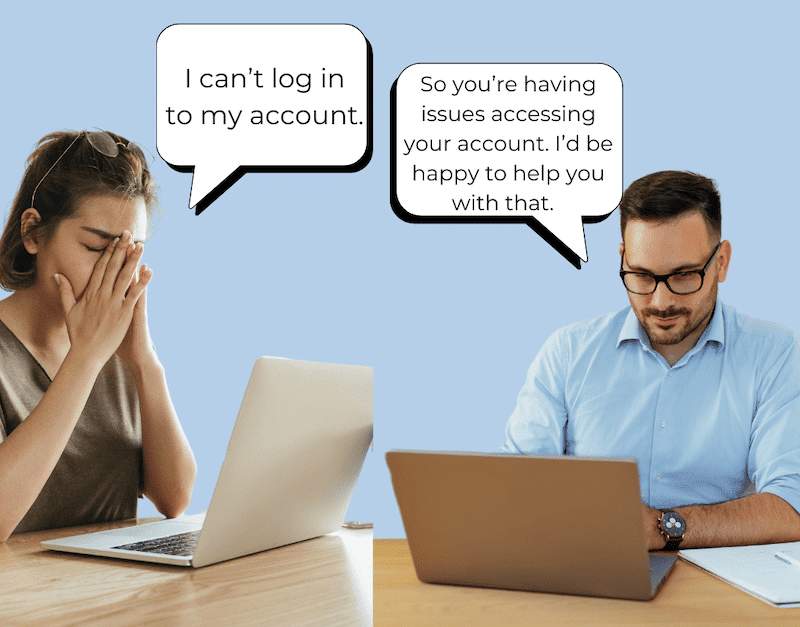
What Are The Best Practices for Handling Difficult Customers?
- Stay Calm and Professional: In high-tension situations, it’s crucial to remain composed. Studies show that customers are more likely to stay loyal to a company if their issues are handled with professionalism. Avoid getting defensive or confrontational, as this can escalate the situation.
- Listen Actively: Active listening is key in customer service. Statistics indicate that customers feel more valued when they are heard without interruption. This approach not only helps in understanding the issue better but also builds trust.
- Empathize and Validate: Empathy goes a long way. Research has found that customer satisfaction increases significantly when service agents actively express empathy. Acknowledge the customer’s feelings and frustrations, reassuring them that their concerns are both understood and valid. Understanding how to respond to a frustrated customer email involves demonstrating empathy in your responses to enhance customer satisfaction.
- Apologize and Take Responsibility: A sincere apology can defuse a difficult situation. Take ownership of any mistakes and commit to resolving them.
- Provide a Solution: Collaborate with the customer to find a resolution. Offering multiple options can be effective; a study by the Harvard Business Review suggests that when customers are provided with alternatives, their satisfaction doubles compared to being given a single solution.
- Follow-up: The follow-up is just as important as the initial interaction. Data shows that customers whose issues are resolved quickly and followed up on are 8 times more likely to recommend the company to others. Make sure the issue is fully resolved and check back in with the customer to demonstrate your commitment to their satisfaction.
General Tips for Crafting Effective Email Responses
When dealing with angry customers, keep these general tips in mind to ensure your email responses are effective:
- Stay Calm and Professional: It is crucial to maintain a calm demeanor when dealing with customer complaints. Responding with professionalism, regardless of the customer’s tone or approach, sets the stage for a constructive interaction. Avoid any defensive or confrontational language that could escalate the situation.
- Listen Actively and Empathize: Active listening involves giving your full attention to the customer, acknowledging their concerns, and responding thoughtfully. Empathizing with the customer’s situation helps in building a rapport and demonstrates that you are not just hearing them but truly understanding their issues.
- Apologize and Take Responsibility: A sincere apology can go a long way in diffusing tension. Taking responsibility for any errors or misunderstandings, even if they were not directly your fault, shows the customer that you are committed to making things right and value their satisfaction.
- Provide Clear Solutions: After understanding the problem, it is important to offer clear and actionable solutions. Work with the customer to find an outcome that addresses their concerns while staying within the boundaries of what your company can reasonably do. Providing options gives the customer a sense of control over the resolution process.
How to Improve Customer Service Response Times?
- Use Automated Responses: Automate the initial customer contact by setting up email or chatbot responses that immediately acknowledge receipt of customer queries. For example, configure your system to send an automated message stating, “Thank you for reaching out to us. We have received your query and will get back to you within 24 hours.”
- Prioritize Urgent Issues: Effective customer support hinges on timely and appropriate responses to customer inquiries. This system helps your team manage their workload efficiently while meeting customer expectations for quick response times. Understanding how to respond to a frustrated customer email is essential in this context, as it directly affects customer perception and satisfaction.
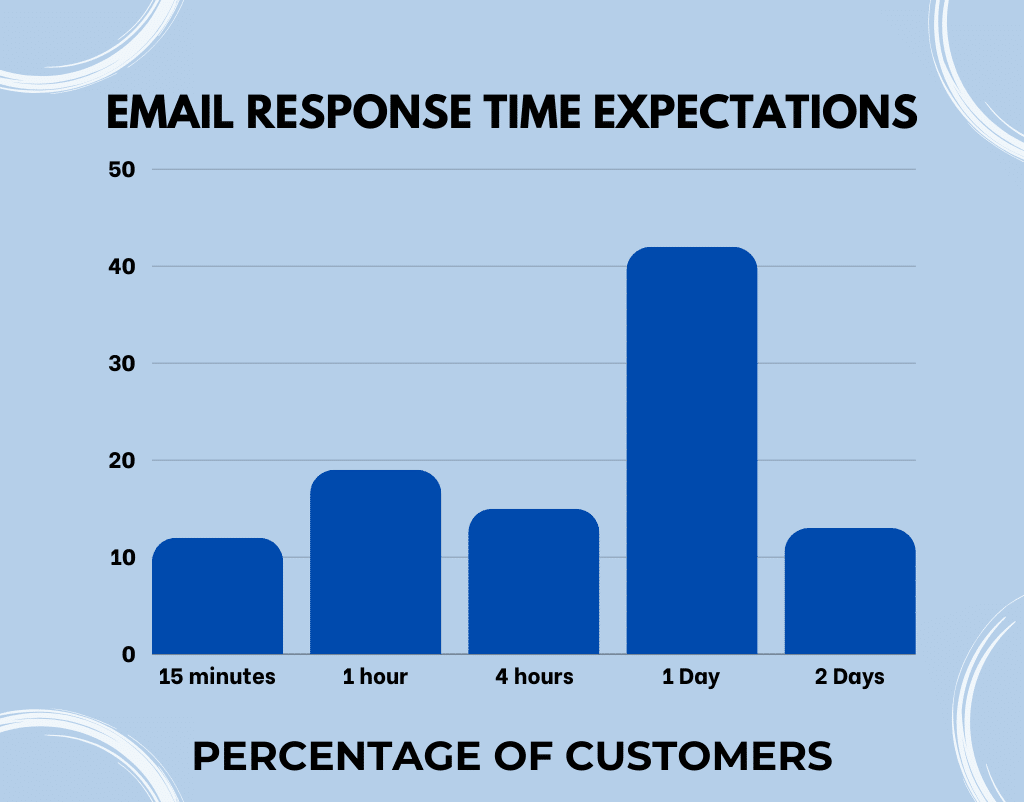
- Use Customer Service Software: Invest in robust customer service software that offers ticketing systems and helps organize and track customer inquiries. Tools like Zendesk or Freshdesk can automatically sort tickets by issue type, priority, and other criteria, enabling your team to manage workflows more effectively.
- Train Your Team: Provide comprehensive training programs for your customer service representatives. Regular workshops on product updates, communication skills, and problem-solving can empower your team to handle inquiries with greater competence and speed.
- Monitor Performance: Use analytics tools to regularly review response times and customer feedback. By analyzing trends and identifying bottlenecks, you can implement targeted improvements. For example, if data shows that response times lag during lunch hours, you might consider staggering lunch breaks among staff.
- Allocate Resources: Plan your staffing levels according to anticipated inquiry volumes, taking into account seasonal fluctuations and marketing campaigns that may increase demand. Understanding how to respond to a frustrated customer email is crucial, and it’s also beneficial to cross-train employees from other departments to provide additional support during peak periods.
Template Overview
Template 1: Expressing Genuine Empathy and Understanding
Purpose:
This template is designed to convey genuine empathy and understanding towards a customer who has experienced a frustrating situation. It aims to acknowledge the customer’s feelings, offer heartfelt apologies, and demonstrate that their concerns are being taken seriously.
When to Use:
Use this template when a customer has expressed significant frustration or disappointment, and you need to show them that you understand their feelings and are committed to resolving the issue.
Why It Works:
Expressing empathy and understanding helps to humanize your response, making the customer feel heard and valued. This approach can help to de-escalate the situation, paving the way for constructive dialogue and resolution.
Subject: We Hear You, [Customer’s First Name]

Template 2: Acknowledging the Customer’s Frustration
Purpose:
This template de-escalates a situation by directly acknowledging the customer’s frustration and disappointment. By validating their feelings, you create an opening for a constructive conversation and demonstrate that their concerns are important to you.
When to Use:
Use this template when a customer expresses anger or dissatisfaction with your product or service. This approach helps in calming the customer by showing that their emotions are recognized and taken seriously.
Why It Works:
Directly acknowledging a customer’s frustration shows empathy and respect for their feelings. This validation can make customers feel heard, which often leads to a more cooperative and positive interaction.
Subject: We Understand Your Frustration, [Customer’s First Name]

Template 3: Offering a Sincere Apology on Behalf of the Company
Purpose:
This template provides a straightforward and genuine apology to a customer who has had a negative experience. It aims to acknowledge the company’s shortcomings without trying to deflect or dilute the sentiment with excessive explanations or justifications.
When to Use:
Use this template when a customer has expressed dissatisfaction and the primary need is for a sincere apology and recognition of the company’s responsibility. It is especially effective when the issue is clearly the company’s fault, and the customer deserves a straightforward acknowledgment and apology.
Why It Works:
A simple, heartfelt apology can go a long way in restoring a customer’s trust. Owning up to mistakes and expressing genuine regret shows the customer that you value their experience and are committed to making things right.
Subject: Our Sincere Apology, [Customer’s First Name]
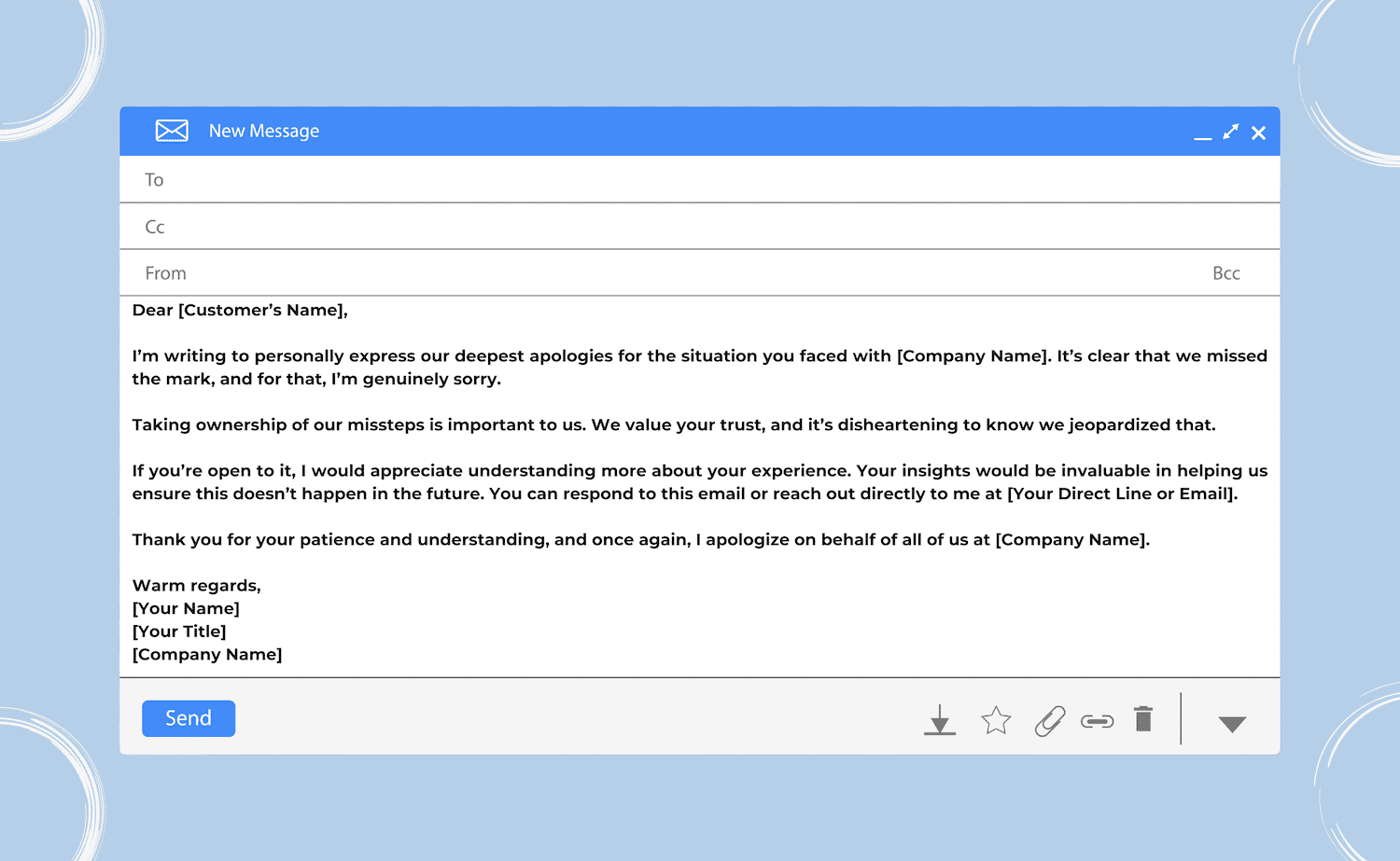
Template 4: Taking Accountability and Assuring Resolution
Purpose:
This template is designed to clearly own up to a mistake or oversight and then confidently assure the customer that the matter will be resolved. Understanding how to respond to a frustrated customer email, it aims to showcase responsibility, commitment, and a proactive approach to addressing the issue.
When to Use:
Use this template when a customer has experienced a significant issue that requires immediate acknowledgment and a detailed plan for resolution. This approach is effective when the company needs to take clear responsibility for the error and outline specific steps to correct it.
Why It Works:
Taking accountability demonstrates integrity and builds trust with the customer. By providing a clear plan of action, you reassure the customer that their issue is being handled seriously and competently, which can help restore their confidence in your company.
Subject: We’re Taking Action, [Customer’s First Name]
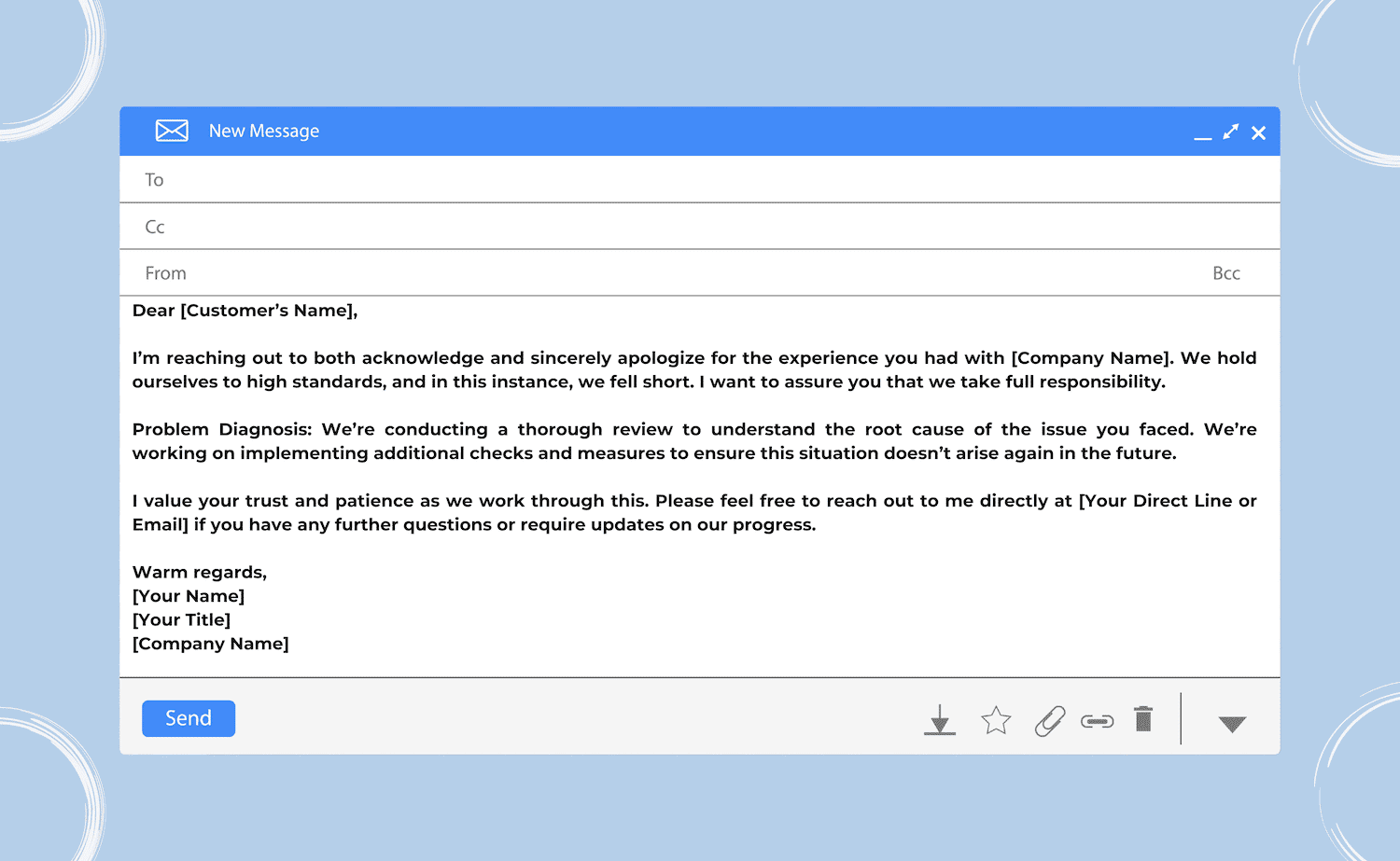
Template 5: Providing Clear Information and Explanation
Purpose:
This template is designed to address customer frustration that arises from confusion or a lack of clarity regarding a product, service, or policy. It aims to provide a detailed and clear explanation to help the customer understand the situation better.
When to Use:
Use this template when misunderstandings or lack of information upset a customer. This approach is effective when you need to clarify policies, procedures, or the specifics of a product or service to resolve the customer’s concern.
Why It Works:
Providing clear and detailed information helps to alleviate confusion and demonstrates that you are attentive and transparent. By addressing the customer’s concerns directly, you can rebuild trust and improve their overall experience.
Subject: Clarity on Your Concerns, [Customer’s First Name]
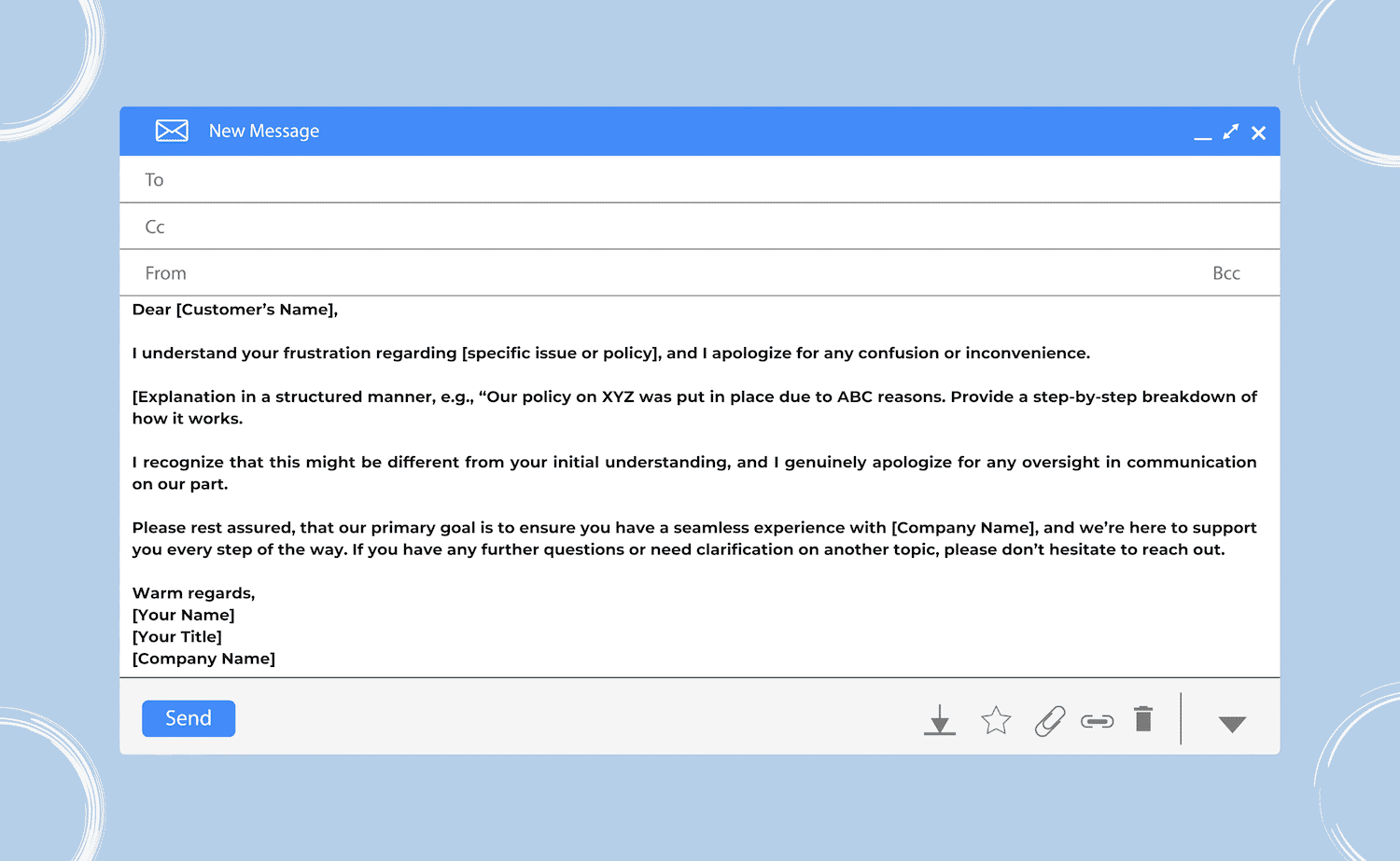
Step-by-Step Guide to Implementing the Templates
Customize Them to Match Your Company’s Voice and Tone
Every company has a unique brand voice and tone that reflects its identity. Ensure that your email templates align with this voice to maintain consistency across all customer communications. This helps reinforce your brand and make your responses more authentic.
Example: If your company’s tone is friendly and casual, use conversational language and add a touch of warmth to your responses. If your brand is more formal and professional, polish your language and ensure it is respectful.
Incorporate Customer-Specific Details for a More Personalized Touch
Personalization is key to making your customers feel valued and understood. Include specific details about the customer’s situation, such as their name, order number, and the specific issue they faced. This shows that you are paying attention and genuinely care about resolving their problem.
Example: “Dear [Customer’s Name], I noticed that your order #[Order Number] was delayed, and I understand how this impacted your plans. We sincerely apologize for this inconvenience.”
Use Examples of Successful Implementations to Guide Your Responses
Learning from past successes can help you craft more effective responses. Understanding how to respond to a frustrated customer email involves referring to instances where you successfully resolved similar issues and using these examples to inform your approach.
Example: “In the past, we faced a similar situation with another customer who experienced a delay in their order. By promptly addressing the issue and offering a discount on their next purchase, we were able to turn their experience around. We plan to take similar steps to ensure your satisfaction.”
Provide Clear and Actionable Steps
Outline the specific actions you are taking to resolve the issue and what the customer can expect next. This transparency builds trust and reassures the customer that you are addressing their concern.
Example: “We have expedited your replacement order, which will be shipped out by the end of the day. You can expect it to arrive within the next two business days. We will also send you a tracking number once it’s dispatched.”
Offer Additional Assistance or Follow-up
Encourage customers to reach out if they have any further questions or need additional support. This open line of communication demonstrates your dedication to their satisfaction beyond just resolving the current issue. Understanding how to respond to a frustrated customer email can help maintain this open communication effectively.
Example: “If you have any more questions or need further assistance, please don’t hesitate to contact us directly. We are here to help and ensure you have a positive experience with our company.”
What to Include in an Apology Email to a Customer?
Acknowledge the Issue
Begin by clearly stating the problem and acknowledging the customer’s frustration. This shows the customer that you are aware of their concerns and are taking them seriously.
Example: “We understand that your recent experience with our product did not meet your expectations, and we recognize how frustrating this must have been for you.”
Sincere Apology
Offer a genuine apology for the inconvenience caused. It’s essential to be heartfelt and sincere to show that you genuinely care about their experience.
Example: “We are truly sorry for the inconvenience this has caused you and apologize for not meeting our usual standards of service.”
Take Responsibility
Own up to any mistakes made by your company. Taking responsibility builds trust and shows that you are committed to accountability.
Example: “We take full responsibility for the issues you encountered and regret any frustration or inconvenience this has caused.”
Explain the Situation
If applicable, provide a brief explanation of what went wrong. This transparency can help the customer understand the context of the issue.
Example: “Due to an unexpected supply chain disruption, we experienced delays that affected your order. We understand how this impacted you and deeply regret the oversight.”
Provide a Solution
Outline the steps you are taking to resolve the issue. Providing a clear and detailed action plan reassures the customer that we are handling their issue promptly and professionally, which helps build trust and satisfaction.
Example: “To rectify this, we have expedited your order and will ensure it reaches you within the next two days.”
Offer Compensation
If appropriate, offer compensation or a goodwill gesture. This can help to mitigate the customer’s dissatisfaction and show your commitment to making things right.
Example: “As a gesture of goodwill, we would like to offer you a 20% discount on your next purchase with us.”
Express Gratitude
Thank the customer for their patience and understanding. Gratitude reinforces that you value their business and appreciate their patience.
Example: “Thank you for your patience and understanding as we work to resolve this issue.”
Follow-up
Ensure you resolve the customer’s issue and follow up to confirm their satisfaction. This approach demonstrates your commitment to providing excellent customer service.
Example: “We will follow up with you in a few days to ensure that the issue has been fully resolved and to check if there is anything else we can assist you with.”
Conclusion
Handling angry customers is an essential skill for maintaining a positive brand image and customer loyalty. By using these 13 email response templates, you can effectively address customer complaints and turn a negative experience into a positive one. Understanding how to respond to a frustrated customer email is key. Give them a try and share your success stories with us!
However, if you could use guidance on email marketing or any aspect of your marketing journey, WolfPack Advising can help! Schedule your online consultation today.


